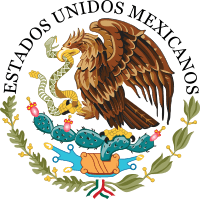Miguel Barragán
| Miguel Barragán | |
|---|---|
 | |
9th President of Mexico | |
|
In office 28 January 1835 – 27 February 1836 | |
| Preceded by | Antonio López de Santa Anna |
| Succeeded by | José Justo Corro |
| Governor of Veracruz | |
|
In office 1825–1828 | |
| Succeeded by | Sebastián Camacho Castilla |
| Personal details | |
| Born |
8 March 1789 Ciudad del Maíz, San Luis Potosí |
| Died |
1 March 1836 (aged 46) Mexico City |
| Nationality | Mexican |
| Spouse(s) | Manuela Trebesto y Casasola |
Miguel Francisco Barragán Andrade (8 March 1789 – 1 March 1836) was a Mexican general and centralist politician. He served as Minister of War in the government of Antonio López de Santa Anna in 1833 and 1834, then as president of Mexico from 28 January 1835 to 27 February 1836.
Career
The War of Independence and the First Empire
Barragán fought with Ejército Trigarante in the Mexican War of Independence, rising to the rank of brigadier general. After independence, he joined a conspiracy against Emperor Agustín de Iturbide with other ex-insurgents. They met in the house of Miguel Domínguez, ex-corregidor of Querétaro. The conspirators wrote to Pedro Celestino Negrete in Guadalajara, expecting support. Instead, he denounced the conspiracy to Iturbide. Seventeen people were arrested, including Guadalupe Victoria, Brigadier Nicolás Bravo and Barragán. Barragán was not freed until after the fall of the empire.
On 20 June 1824, he was named commanding general of Veracruz, which was under bombardment from the Spanish in the fort of San Juan de Ulúa, the only position the Spanish still held in Mexico. Barragán blockaded the fort with two small ships. The Spanish garrison was suffering from hunger and illness. The Spanish commander, José María Coppinger, surrendered on 6 November 1825, under a pact of 14 articles. The pact was ratified on 18 November, and Barragán occupied Ulúa on that day. All of Mexico was now free of Spanish control. In recognition of the results, Congress named Barragán political chief of the state of Veracruz in 1828.
Republic of Mexico
He was compromised in the 1827 Plan de Montaño, an armed uprising against President Guadalupe Victoria that aimed to prohibit secret meetings of the Yorkists and force the expulsion of Joel Roberts Poinsett, the diplomatic representative of the United States. Colonel José Rincón, under Barragán's command in Veracruz, denounced the conspirators. Barragán was arrested at the hacienda of Santa Anna and confined in the dungeons formerly used by the Inquisition. Generals Guadalupe Victoria and Vicente Guerrero intervened on his behalf, and he was sentenced only to temporary exile. He lived in Ecuador, Guatemala and the United States.
Called back to Mexico by Santa Anna, he was Minister of War from 20 November 1833 to 13 February 1834 in the governments of Santa Anna and Valentín Gómez Farías. (He was a political supporter of Santa Anna.) During this period, Barragán and Quintanar were sent to suppress rebels in the state of Jalisco.
President of Mexico
On 28 January 1835, Barragán replaced Santa Anna in the presidency on an interim basis. Legally, Santa Anna had to give up the presidency while he was acting as commander in chief of the armed forces. Barragán took measures to help widows and poor people, partly out of his own pocket. He also suppressed an anti-Santa Anna revolt in the current state of Guerrero. He served until 27 February 1836, when he resigned because of a grave illness. He died in the National Palace on 1 March 1836, a victim of a "putrid fever" (probably typhus). He was interred in the Mexico City Metropolitan Cathedral, and his name was inscribed in letters of gold in the chamber where Congress met. José Justo Corro succeeded him in office.
See also
References
- (Spanish) "Barragán, Miguel", Enciclopedia de México, v. 2. Mexico City, 1996, ISBN 1-56409-016-7.
- (Spanish) García Puron, Manuel, México y sus gobernantes, v. 2. Mexico City: Joaquín Porrúa, 1984.
- (Spanish) Orozco Linares, Fernando, Gobernantes de México. Mexico City: Panorama Editorial, 1985, ISBN 968-38-0260-5.
External links
- Short biography at El Balero (in Spanish).
| Political offices | ||
|---|---|---|
| Preceded by Antonio López de Santa Anna |
President of Mexico 28 January 1835 - 27 February 1836 |
Succeeded by José Justo Corro |
